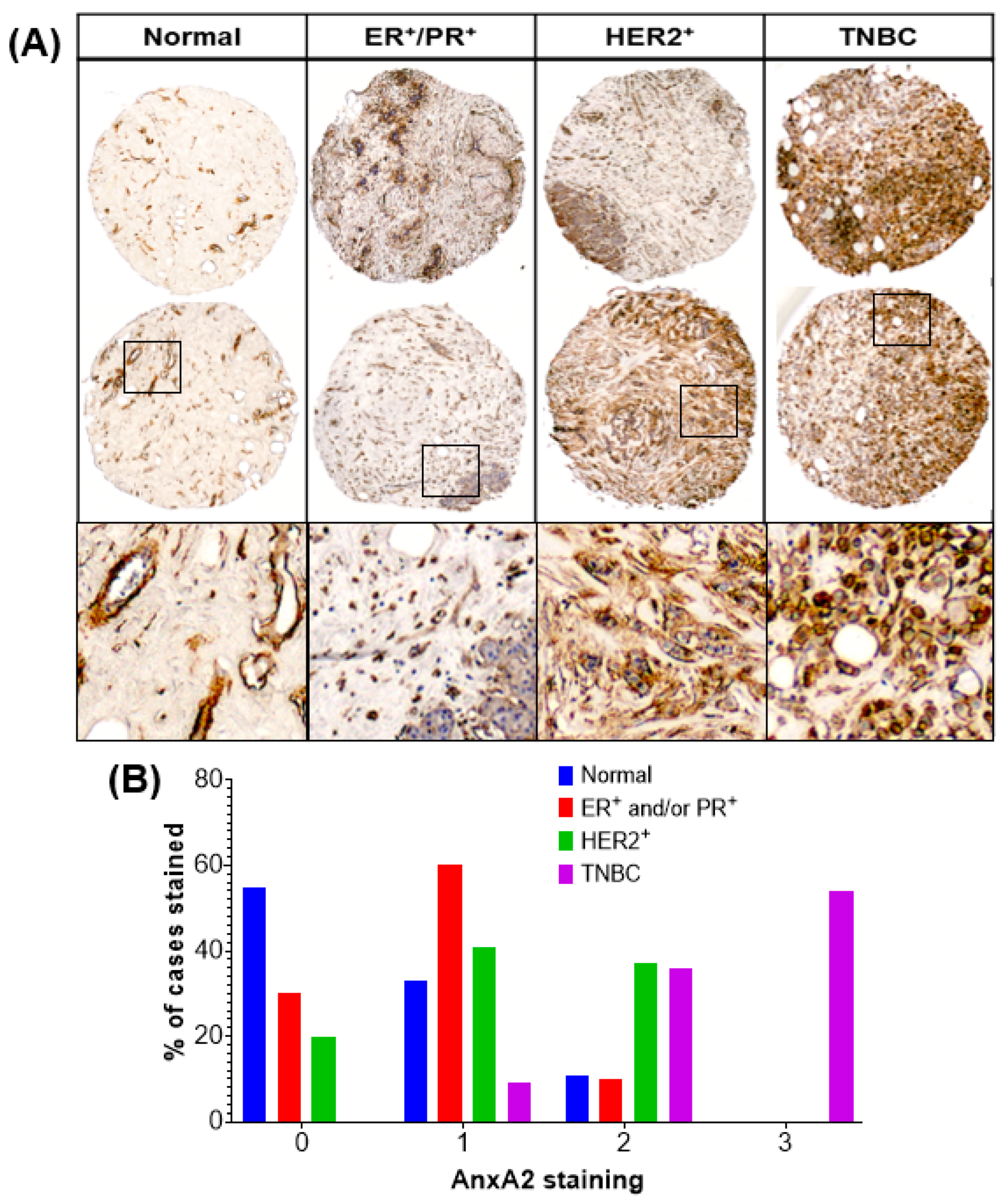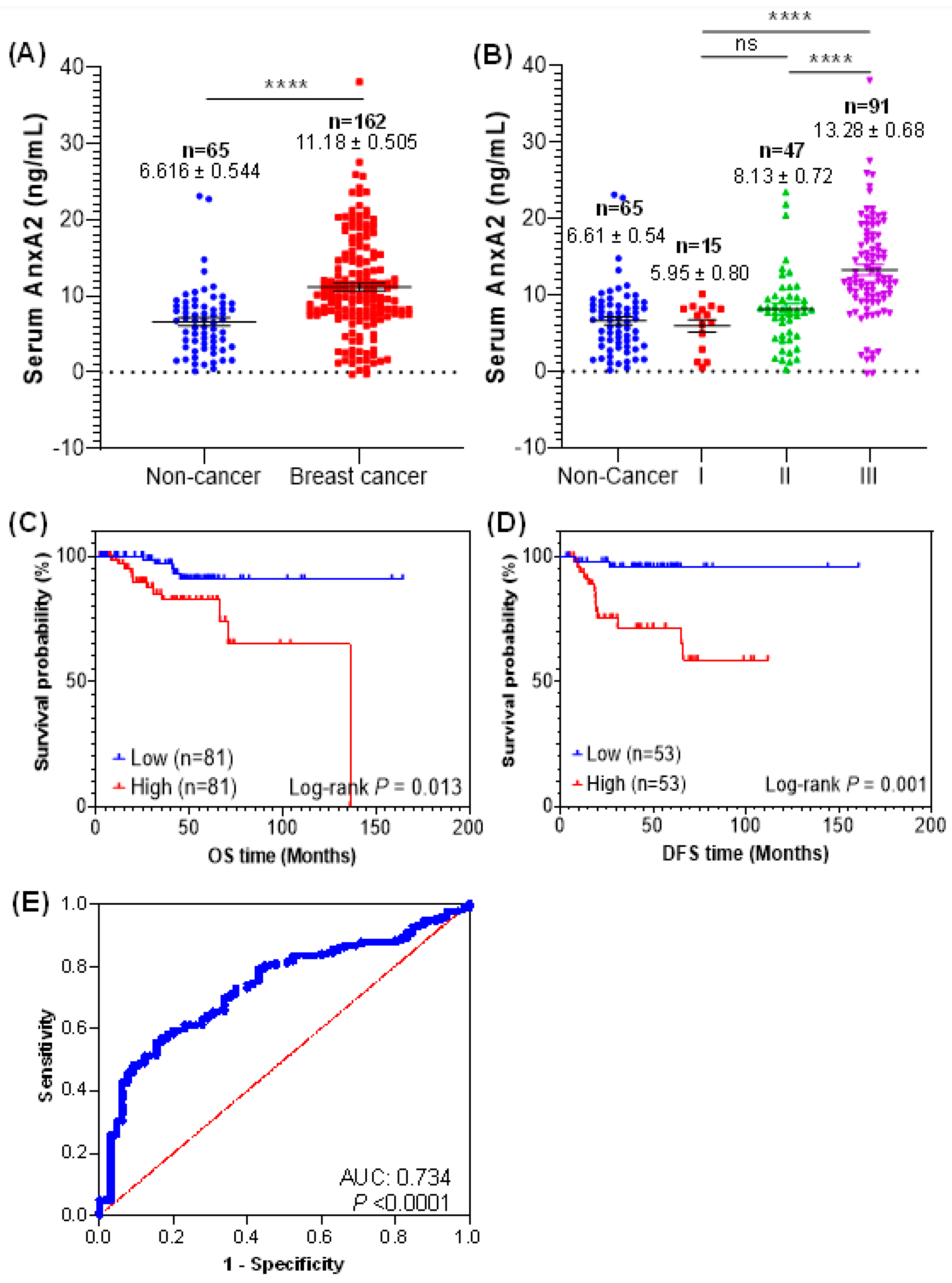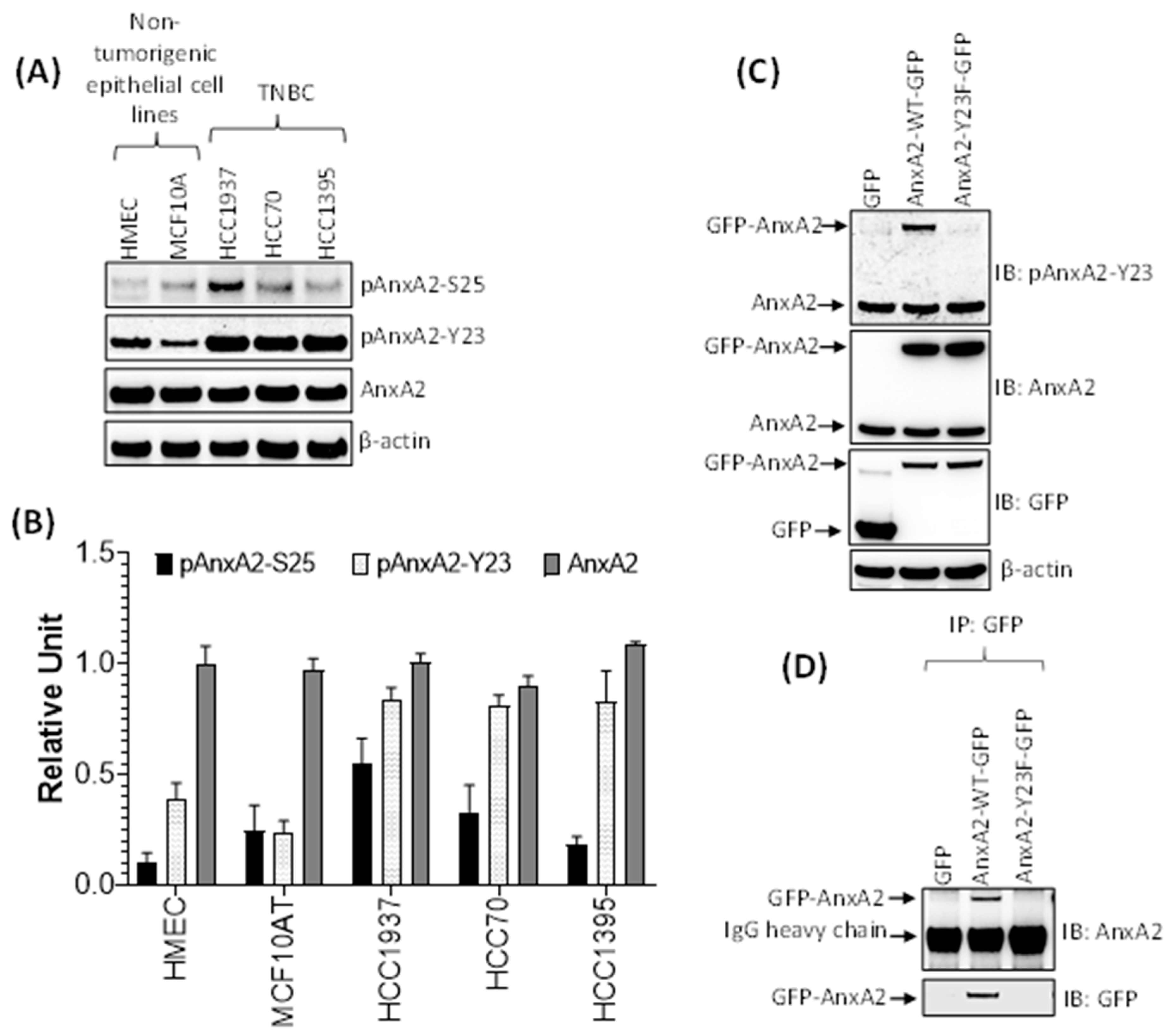Clinical Significance of Annexin A2 Expression in Breast Cancer Patients
Abstract
Simple Summary
Abstract
1. Introduction
2. Results
2.1. AnxA2 Expression in Tumor Tissues of Breast Cancer Patients
2.2. Serum AnxA2 Levels in Breast Cancer Patients
2.3. Prognostic and Diagnostic Significance of Serum AnxA2 in Breast Cancer Patients
2.4. Elevated Expression of Serum AnxA2 is Associated with TNBC Subtypes
2.5. Serum AnxA2 Has Good Diagnostic Value for Triple-Negative Subtype of Breast Cancer
2.6. AnxA2 Secretion Levels in Normal Mammary Epithelial Cell Lines and Breast Cancer Cell Lines with Different Subtypes
2.7. Phosphorylation of AnxA2 at Tyr 23 is Associated with High Secretion of AnxA2 in TNBC
3. Discussion
4. Materials and Methods
4.1. Cell Lines and Culture Conditions
4.2. Materials
4.3. Preparation of Cell Extracts and Immunoblot Analysis
4.4. Immunoprecipitation Studies
4.5. Plasmids and Constructs
4.6. Tumor Tissues and Serum Samples Collection
4.7. Immunohistochemical Staining
4.8. Serum AnxA2 Quantification
4.9. Statistical Analysis
5. Conclusions
Supplementary Materials
Author Contributions
Funding
Institutional Review Board Statement
Informed Consent Statement
Data Availability Statement
Conflicts of Interest
References
- Siegel, R.L.; Miller, K.D.; Jemal, A. Cancer statistics, 2020. CA Cancer J. Clin. 2020, 70, 7–30. [Google Scholar] [CrossRef] [PubMed]
- Zardavas, D.; Pugliano, L.; Piccart, M. Personalized therapy for breast cancer: A dream or a reality? Future Oncol. 2013, 9, 1105–1119. [Google Scholar] [CrossRef] [PubMed]
- Rivenbark, A.G.; O’Connor, S.M.; Coleman, W.B. Molecular and cellular heterogeneity in breast cancer: Challenges for personalized medicine. Am. J. Pathol. 2013, 183, 1113–1124. [Google Scholar] [CrossRef] [PubMed]
- Ades, F.; Zardavas, D.; Aftimos, P.; Awada, A. Anticancer drug development: Moving away from the old habits. Curr. Opin. Oncol. 2014, 26, 334–339. [Google Scholar] [CrossRef]
- Hudis, C.A. Trastuzumab-mechanism of action and use in clinical practice. N. Engl. J. Med. 2007, 357, 39–51. [Google Scholar] [CrossRef]
- Toss, A.; Cristofanilli, M. Molecular characterization and targeted therapeutic approaches in breast cancer. Breast Cancer Res. 2015, 17, 60. [Google Scholar] [CrossRef]
- Perou, C.M.; Sørlie, T.; Eisen, M.B.; van de Rijn, M.; Jeffrey, S.S.; Rees, C.A.; Pollack, J.R.; Ross, D.T.; Johnsen, H.; Akslen, L.A.; et al. Molecular portraits of human breast tumours. Nature 2000, 406, 747–752. [Google Scholar] [CrossRef]
- Sørlie, T.; Perou, C.M.; Tibshirani, R.; Aas, T.; Geisler, S.; Johnsen, H.; Hastie, T.; Eisen, M.B.; van de Rijn, M.; Jeffrey, S.S.; et al. Gene expression patterns of breast carcinomas distinguish tumor subclasses with clinical implications. Proc. Natl. Acad. Sci. USA 2001, 98, 10869–10874. [Google Scholar] [CrossRef]
- Sotiriou, C.; Neo, S.Y.; McShane, L.M.; Korn, E.L.; Long, P.M.; Jazaeri, A.; Martiat, P.; Fox, S.B.; Harris, A.L.; Liu, E.T. Breast cancer classification and prognosis based on gene expression profiles from a population-based study. Proc. Natl. Acad. Sci. USA 2003, 100, 10393–10398. [Google Scholar] [CrossRef]
- Gerke, V.; Creutz, C.E.; Moss, S.E. Annexins: Linking Ca2+ signalling to membrane dynamics. Nat. Rev. Mol. Cell Biol. 2005, 6, 449–461. [Google Scholar] [CrossRef]
- Raynal, P.; Pollard, H.B. Annexins: The problem of assessing the biological role for a gene family of multifunctional calcium-and phospholipid-binding proteins. Biochim. Biophys. Acta 1994, 1197, 63–93. [Google Scholar] [CrossRef]
- Swairjo, M.A.; Seaton, B.A. Annexin Structure and Membrane Interactions: A Molecular Perspective. Annu. Rev. Biophys. Biomol. Struct. 1994, 23, 193–213. [Google Scholar] [CrossRef] [PubMed]
- Bharadwaj, A.; Bydoun, M.; Holloway, R.; Waisman, D. Annexin A2 heterotetramer: Structure and function. Int. J. Mol. Sci. 2013, 14, 6259–6305. [Google Scholar] [CrossRef] [PubMed]
- Grindheim, A.K.; Saraste, J.; Vedeler, A. Protein phosphorylation and its role in the regulation of Annexin A2 function. Biochim. Biophys. Acta Gen. Subj. 2017, 1861, 2515–2529. [Google Scholar] [CrossRef]
- Glenney, J.R., Jr.; Tack, B.F. Amino-terminal sequence of p36 and associated p10: Identification of the site of tyrosine phosphorylation and homology with S-100. Proc. Natl. Acad. Sci. USA 1985, 82, 7884–7888. [Google Scholar] [CrossRef]
- Gould, K.L.; Woodgett, J.R.; Isacke, C.M.; Hunter, T. The protein-tyrosine kinase substrate p36 is also a substrate for protein kinase C in vitro and in vivo. Mol. Cell Biol. 1986, 6, 2738–2744. [Google Scholar] [CrossRef]
- Johnsson, N.; van Nguyen, P.; Soling, H.D.; Weber, K. Functionally distinct serine phosphorylation sites of p36, the cellular substrate of retroviral protein kinase; differential inhibition of reassociation with p11. EMBO J. 1986, 5, 3455–3460. [Google Scholar] [CrossRef]
- Rescher, U.; Gerke, V. Annexins—Unique membrane binding proteins with diverse functions. J. Cell Sci. 2004, 117, 2631–2639. [Google Scholar] [CrossRef]
- Lokman, N.A.; Ween, M.P.; Oehler, M.K.; Ricciardelli, C. The role of annexin A2 in tumorigenesis and cancer progression. Cancer Microenviron. 2011, 4, 199–208. [Google Scholar] [CrossRef]
- Christensen, M.V.; Høgdall, C.K.; Jochumsen, K.M.; Høgdall, E.V.S. Annexin A2 and cancer: A systematic review. Int. J. Oncol. 2018, 52, 5–18. [Google Scholar] [CrossRef]
- Rescher, U.; Ludwig, C.; Konietzko, V.; Kharitonenkov, A.; Gerke, V. Tyrosine phosphorylation of annexin A2 regulates Rho-mediated actin rearrangement and cell adhesion. J. Cell Sci. 2008, 121, 2177–2185. [Google Scholar] [CrossRef] [PubMed]
- Ling, Q.; Jacovina, A.T.; Deora, A.; Febbraio, M.; Simantov, R.; Silverstein, R.L.; Hempstead, B.; Mark, W.H.; Hajjar, K.A. Annexin II regulates fibrin homeostasis and neoangiogenesis in vivo. J. Clin. Investig. 2004, 113, 38–48. [Google Scholar] [CrossRef] [PubMed]
- Valapala, M.; Vishwanatha, J.K. Lipid raft endocytosis and exosomal transport facilitate extracellular trafficking of annexin A2. J. Biol. Chem. 2011, 286, 30911–30925. [Google Scholar] [CrossRef] [PubMed]
- Sharma, M.C. Annexin A2 (ANX A2): An emerging biomarker and potential therapeutic target for aggressive cancers. Int. J. Cancer 2019, 144, 2074–2081. [Google Scholar] [CrossRef] [PubMed]
- Hajjar, K.A.; Jacovina, A.T.; Chacko, J. An endothelial cell receptor for plasminogen/tissue plasminogen activator. I. Identity with annexin II. J. Biol. Chem. 1994, 269, 21191–21197. [Google Scholar]
- Cesarman, G.M.; Guevara, C.A.; Hajjar, K.A. An endothelial cell receptor for plasminogen/tissue plasminogen activator (t-PA). II. Annexin II-mediated enhancement of t-PA-dependent plasminogen activation. J. Biol. Chem. 1994, 269, 21198–21203. [Google Scholar]
- Hajjar, K.A.; Mauri, L.; Jacovina, A.T.; Zhong, F.; Mirza, U.A.; Padovan, J.C.; Chait, B.T. Tissue plasminogen activator binding to the annexin II tail domain. Direct modulation by homocysteine. J. Biol. Chem. 1998, 273, 9987–9993. [Google Scholar] [CrossRef]
- Sharma, M.R.; Koltowski, L.; Ownbey, R.T.; Tuszynski, G.P.; Sharma, M.C. Angiogenesis-associated protein annexin II in breast cancer: Selective expression in invasive breast cancer and contribution to tumor invasion and progression. Exp. Mol. Pathol. 2006, 81, 146–156. [Google Scholar] [CrossRef]
- Shetty, P.; Thamake, I.; Biswas, S.; Johansson, S.L.; Vishwanatha, J.K. Reciprocal regulation of Annexin A2 and EGFR with Her-2 in Her-2 negative and Herceptin-resistant breast cancer. PLoS ONE 2012, 7, e44299. [Google Scholar] [CrossRef]
- Gibbs, L.D.; Vishwanatha, J.K. Prognostic impact of AnxA1 and AnxA2 gene expression in triple-negative breast cancer. Oncotarget 2017, 9, 2697–2704. [Google Scholar] [CrossRef]
- Gibbs, L.D.; Chaudhary, P.; Mansheim, K.; Hare, R.J.; Mantsch, R.A.; Vishwanatha, J.K. ANXA2 expression in African American triple-negative breast cancer patients. Breast Cancer Res. Treat. 2019, 174, 113–120. [Google Scholar] [CrossRef] [PubMed]
- Jeon, Y.R.; Kim, S.Y.; Lee, E.J.; Kim, Y.N.; Noh, D.Y.; Park, S.Y.; Moon, A. Identification of annexin II as a novel secretory biomarker for breast cancer. Proteomics 2013, 13, 3145–3156. [Google Scholar] [CrossRef] [PubMed]
- Hedhli, N.; Falcone, D.J.; Huang, B.; Cesarman-Maus, G.; Kraemer, R.; Zhai, H.; Tsirka, S.E.; Santambrogio, L.; Hajjar, K.A. The annexin A2/S100A10 system in health and disease: Emerging paradigms. J. Biomed. Biotechnol. 2012, 2012, 406273. [Google Scholar] [CrossRef]
- Dallacasagrande, V.; Hajjar, K.A. Annexin A2 in Inflammation and Host Defense. Cells 2020, 9, 1499. [Google Scholar] [CrossRef] [PubMed]
- Xu, X.H.; Pan, W.; Kang, L.H.; Feng, H.; Song, Y.Q. Association of annexin A2 with cancer development (Review). Oncol. Rep. 2015, 33, 2121–2128. [Google Scholar] [CrossRef] [PubMed]
- Maji, S.; Chaudhary, P.; Akopova, I.; Nguyen, P.M.; Hare, R.J.; Gryczynski, I.; Vishwanatha, J.K. Exosomal annexin II promotes angiogenesis and breast cancer metastasis. Mol. Cancer Res. 2017, 15, 93–105. [Google Scholar] [CrossRef]
- Sharma, M.C.; Tuszynski, G.P.; Blackman, M.R.; Sharma, M. Long-term efficacy and downstream mechanism of anti-annexinA2 monoclonal antibody (anti-ANX A2 mAb) in a pre-clinical model of aggressive human breast cancer. Cancer Lett. 2016, 373, 27–35. [Google Scholar] [CrossRef]
- Chaudhary, P.; Thamake, S.I.; Shetty, P.; Vishwanatha, J.K. Inhibition of triple-negative and Herceptin-resistant breast cancer cell proliferation and migration by Annexin A2 antibodies. Br. J. Cancer 2014, 111, 2328–2341. [Google Scholar] [CrossRef]
- Myrvang, H.K.; Guo, X.; Li, C.; Dekker, L.V. Protein interactions between surface annexin A2 and S100A10 mediate adhesion of breast cancer cells to microvascular endothelial cells. FEBS Lett. 2013, 587, 3210–3215. [Google Scholar] [CrossRef]
- Zhang, F.; Zhang, L.; Zhang, B.; Wei, X.; Yang, Y.; Qi, R.Z.; Ying, G.; Zhang, N.; Niu, R. Anxa2 plays a critical role in enhanced invasiveness of the multidrug resistant human breast cancer cells. J. Proteome Res. 2009, 8, 5041–5047. [Google Scholar] [CrossRef]
- Mahdi, A.F.; Malacrida, B.; Nolan, J.; McCumiskey, M.E.; Merrigan, A.B.; Lal, A.; Tormey, S.; Lowery, A.J.; McGourty, K.; Kiely, P.A. Expression of Annexin A2 Promotes Cancer Progression in Estrogen Receptor Negative Breast Cancers. Cells 2020, 9, 1582. [Google Scholar] [CrossRef] [PubMed]
- Faure, A.V.; Migné, C.; Devilliers, G.; Ayala-Sanmartin, J. Annexin 2 “secretion” accompanying exocytosis of chromaffin cells: Possible mechanisms of annexin release. Exp. Cell Res. 2002, 276, 79–89. [Google Scholar] [CrossRef] [PubMed]
- Tas, F.; Yasasever, C.T.; Karabulut, S.; Tastekin, D.; Duranyildiz, D. Circulating annexin A2 as a biomarker in gastric cancer patients: Correlation with clinical variables. Biomed. Pharmacother. 2015, 69, 237–241. [Google Scholar] [CrossRef] [PubMed]
- Zhang, W.; Gao, C.; Zhang, S.; Fang, G. Serum annexin A2 level is associated with diagnosis and prognosis in patients with oral squamous cell carcinoma. J. Oral Maxillofac. Surg. 2017, 75, 1081–1087. [Google Scholar] [CrossRef]
- Alonso-Alconada, L.; Santacana, M.; Garcia-Sanz, P.; Muinelo-Romay, L.; Colas, E.; Mirantes, C.; Monge, M.; Cueva, J.; Oliva, E.; Soslow, R.A.; et al. Annexin-A2 as predictor biomarker of recurrent disease in endometrial cancer. Int. J. Cancer 2015, 136, 1863–1873. [Google Scholar] [CrossRef]
- Sun, Y.; Gao, G.; Cai, J.; Wang, Y.; Qu, X.; He, L.; Liu, F.; Zhang, Y.; Lin, K.; Ma, S.; et al. Annexin A2 is a discriminative serological candidate in early hepatocellular carcinoma. Carcinogenesis 2013, 34, 595–604. [Google Scholar] [CrossRef]
- Zhang, H.J.; Yao, D.F.; Yao, M.; Huang, H.; Wu, W.; Yan, M.J.; Yan, X.D.; Chen, J. Expression characteristics and diagnostic value of annexin A2 in hepatocellular carcinoma. World J. Gastroenterol. 2012, 18, 5897–5904. [Google Scholar] [CrossRef]
- Ji, N.Y.; Park, M.Y.; Kang, Y.H.; Lee, C.I.; Kim, D.G.; Yeom, Y.I.; Jang, Y.J.; Myung, P.K.; Kim, J.W.; Lee, H.G.; et al. Evaluation of annexin II as a potential serum marker for hepatocellular carcinoma using a developed sandwich ELISA method. Int. J. Mol. Med. 2009, 24, 765–771. [Google Scholar]
- Chaudhary, P.; Gibbs, L.D.; Maji, S.; Lewis, C.M.; Suzuki, S.; Vishwanatha, J.K. Serum exosomal-annexin A2 is associated with African-American triple-negative breast cancer and promotes angiogenesis. Breast Cancer Res. 2020, 22, 11. [Google Scholar] [CrossRef]
- Kaplan, E.L.; Meier, P. Nonparametric estimation from incomplete observations. J. Am. Stat. Assoc. 1958, 53, 457–481. [Google Scholar] [CrossRef]
- Youden, W.J. Index for rating diagnostic tests. Cancer 1950, 3, 32–35. [Google Scholar] [CrossRef]






| Type | Cases (n) | AnxA2 Expression (%) | χ2 and p-Value | |||
|---|---|---|---|---|---|---|
| No Staining (Score = 0) | Weak Staining (Score = 1) | Moderate Staining (Score = 2) | Strong Staining (Score = 3) | |||
| Normal/Malignant: | ||||||
| Normal | 9 | 5 (55.6) | 3 (33.3) | 1 (11.1) | 0 (0) | χ2 = 12.55 |
| Malignant | 67 | 8 (11.9) | 19 (28.4) | 22 (32.8) | 18 (26.9) | p = 0.0057 |
| ER/PR: | ||||||
| Positive | 10 | 3 (30.0) | 6 (60.0) | 1 (10.0) | 0 (0) | χ2 = 12.39 |
| Negative | 57 | 5 (8.8) | 13 (22.8) | 21 (36.8) | 18 (31.6) | p = 0.0062 |
| HER2: | ||||||
| Positive | 24 | 5 (20.8) | 10 (41.7) | 9 (37.5) | 0 (0) | χ2 = 15.11 |
| Negative | 43 | 3 (7.0) | 9 (20.9) | 13 (30.2) | 18 (41.9) | p = 0.0017 |
| ER/PR/HER2: | ||||||
| Triple-positive | 34 | 8 (23.5) | 16 (47.1) | 10 (29.4) | 0 (0) | χ2 = 35.07 |
| Triple-negative | 33 | 0 (0) | 3 (9.1) | 12 (36.4) | 18 (54.5) | p < 0.0001 |
| Pathological Factors | Cases (n) | Serum AnxA2 Levels (Mean ± SEM, ng/mL) | Unpaired t-Test | p-Value |
|---|---|---|---|---|
| Tumor Size (cm): | ||||
| ≤2 | 84 | 10.94 ± 0.696 | 0.061 | p = 0.9512 |
| >2 | 65 | 11.00 ± 0.718 | ||
| Menopausal Status: | ||||
| Premenopausal | 28 | 10.01 ± 1.071 | ||
| Perimenopausal | 8 | 10.11 ± 2.504 | 0.039 | p = 0.9687 |
| Postmenopausal | 115 | 11.53 ± 0.616 | 1.119 | p = 0.2651 |
| Lymph Node Metastasis: | ||||
| Positive | 58 | 9.946 ± 0.667 | 1.552 | p = 0.1229 |
| Negative | 89 | 11.54 ± 0.708 | ||
| ER: | ||||
| Negative | 110 | 13.74 ± 0.563 | 9.426 | p < 0.0001 |
| Positive | 50 | 5.410 ± 0.425 | ||
| HER2: | ||||
| Negative | 106 | 11.74 ± 0.724 | 1.683 | p = 0.0943 |
| Positive | 54 | 9.938 ± 0.485 | ||
| ER/HER2 vs. TNBC: | ||||
| Triple-negative | 56 | 17.40 ± 0.718 | 12.84 | p < 0.0001 |
| ER + HER2 positive | 104 | 7.761 ± 0.392 | ||
Publisher’s Note: MDPI stays neutral with regard to jurisdictional claims in published maps and institutional affiliations. |
© 2020 by the authors. Licensee MDPI, Basel, Switzerland. This article is an open access article distributed under the terms and conditions of the Creative Commons Attribution (CC BY) license (http://creativecommons.org/licenses/by/4.0/).
Share and Cite
Gibbs, L.D.; Mansheim, K.; Maji, S.; Nandy, R.; Lewis, C.M.; Vishwanatha, J.K.; Chaudhary, P. Clinical Significance of Annexin A2 Expression in Breast Cancer Patients. Cancers 2021, 13, 2. https://doi.org/10.3390/cancers13010002
Gibbs LD, Mansheim K, Maji S, Nandy R, Lewis CM, Vishwanatha JK, Chaudhary P. Clinical Significance of Annexin A2 Expression in Breast Cancer Patients. Cancers. 2021; 13(1):2. https://doi.org/10.3390/cancers13010002
Chicago/Turabian StyleGibbs, Lee D., Kelsey Mansheim, Sayantan Maji, Rajesh Nandy, Cheryl M. Lewis, Jamboor K. Vishwanatha, and Pankaj Chaudhary. 2021. "Clinical Significance of Annexin A2 Expression in Breast Cancer Patients" Cancers 13, no. 1: 2. https://doi.org/10.3390/cancers13010002
APA StyleGibbs, L. D., Mansheim, K., Maji, S., Nandy, R., Lewis, C. M., Vishwanatha, J. K., & Chaudhary, P. (2021). Clinical Significance of Annexin A2 Expression in Breast Cancer Patients. Cancers, 13(1), 2. https://doi.org/10.3390/cancers13010002






